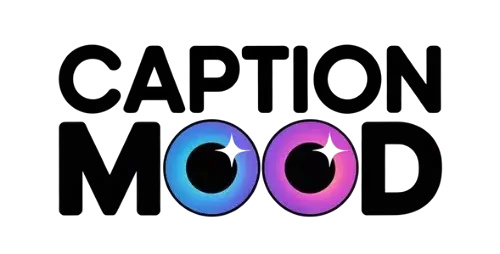Open captions are text displayed directly on the screen, showing spoken dialogue and sound effects for everyone watching. If you’ve ever wondered what does open caption mean, it’s a feature that improves accessibility in movies, TV shows, and theaters. Unlike closed captions, open captions can’t be turned off, making them ideal for deaf or hard-of-hearing viewers and public screenings.
What are Open Captions?
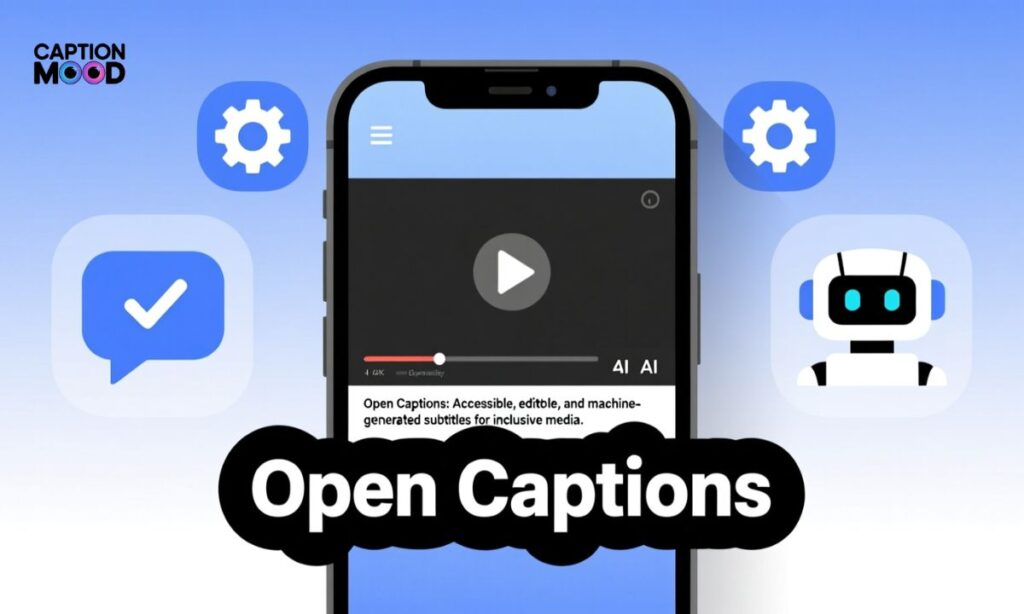
Open captions are permanent on-screen subtitles that display dialogue, sound effects, and other relevant audio cues directly on the video. Unlike closed captions, which viewers can turn on or off, open captions are always visible. They are commonly used in cinemas, social media videos, public screenings, and online platforms to make content accessible to deaf or hard-of-hearing audiences.
In simple terms, open captions ensure that everyone in the room sees the same text, regardless of device or settings.
Advantages of Open Captions
Open captions come with several powerful benefits, both for creators and viewers. Let’s break them down clearly:
| Advantage | Description |
| Accessibility | Helps viewers who are deaf or hard of hearing easily follow along with dialogue and sounds. |
| Comprehension | Improves understanding for non-native speakers or noisy environments. |
| SEO Benefits | When used online, they make videos more searchable and boost engagement on platforms like YouTube. |
| Universal Viewing | No need for viewers to toggle settings; captions are visible to everyone automatically. |
In addition, open captions enhance user experience in places like restaurants, airports, or classrooms, where audio might not be clear. They make your content more inclusive, professional, and globally understandable.
What Does Open Caption Mean
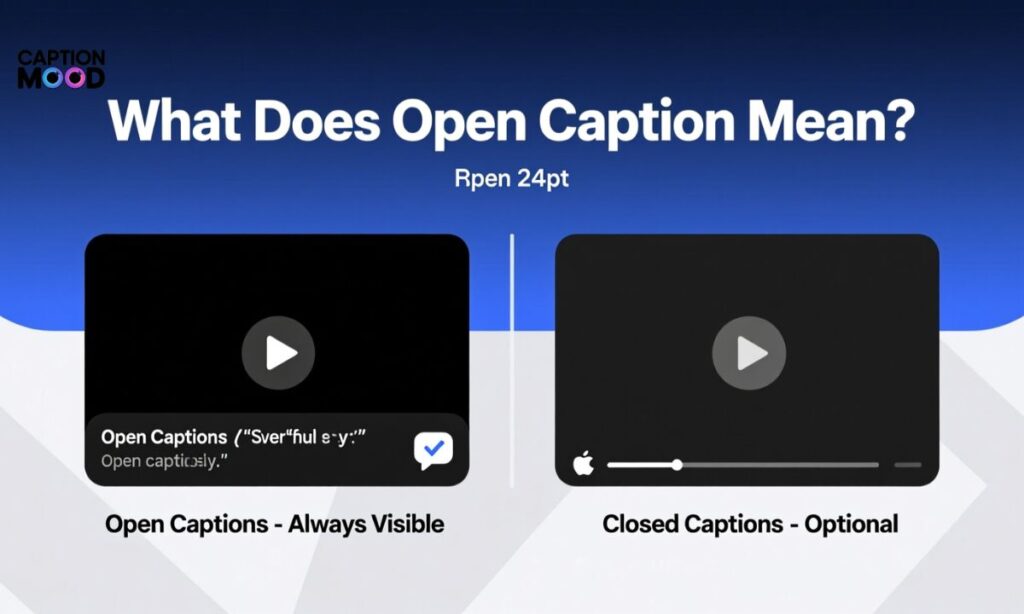
An open caption is text displayed on-screen that shows dialogue, sound effects, or music lyrics for a video or film, and it is permanently visible to all viewers. Unlike closed captions, which can be turned on or off, open captions are always visible, making them ideal for accessibility, noisy environments, or public screenings.
Open captions help people who are deaf or hard of hearing, non-native speakers, or anyone who wants to follow dialogue without sound. They are commonly used in films, online videos, social media content, and educational materials.
What Does Open Caption Mean in Cinema
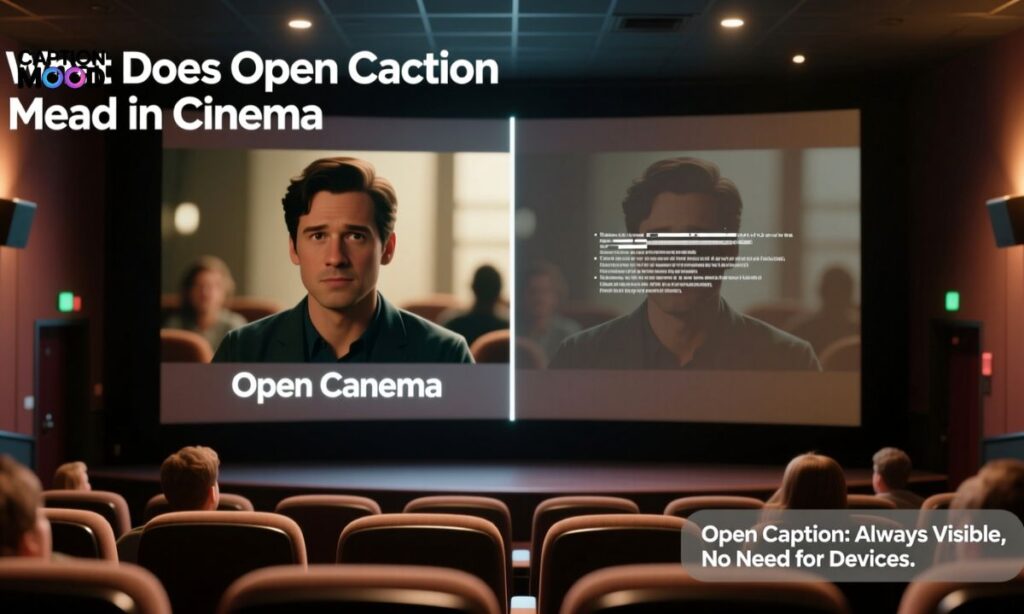
In cinema, open captions refer to subtitles that are projected on the movie screen for all viewers. They display dialogue, speaker identification, and sometimes sound effects or background noises.
Open captions in cinema improve accessibility and inclusivity, allowing audiences with hearing difficulties or language barriers to fully enjoy the movie experience. Many modern theaters now provide specific screenings with open captions, making mainstream films more accessible without requiring special devices or adjustments.
What Does Open Caption Mean in a Movie Theater
In a movie theater, open captions are on-screen text for all audience members, not just those who request them. They usually appear at the bottom of the screen and are synchronized with the film’s dialogue.
Open caption screenings are increasingly offered by theaters to accommodate people with hearing impairments or language difficulties, and they ensure that the entire audience can follow the movie without audio alone. Open captions may also display sound cues like [door creaks] or [dramatic music], enhancing comprehension for everyone.
What Does Open Caption Mean Vue
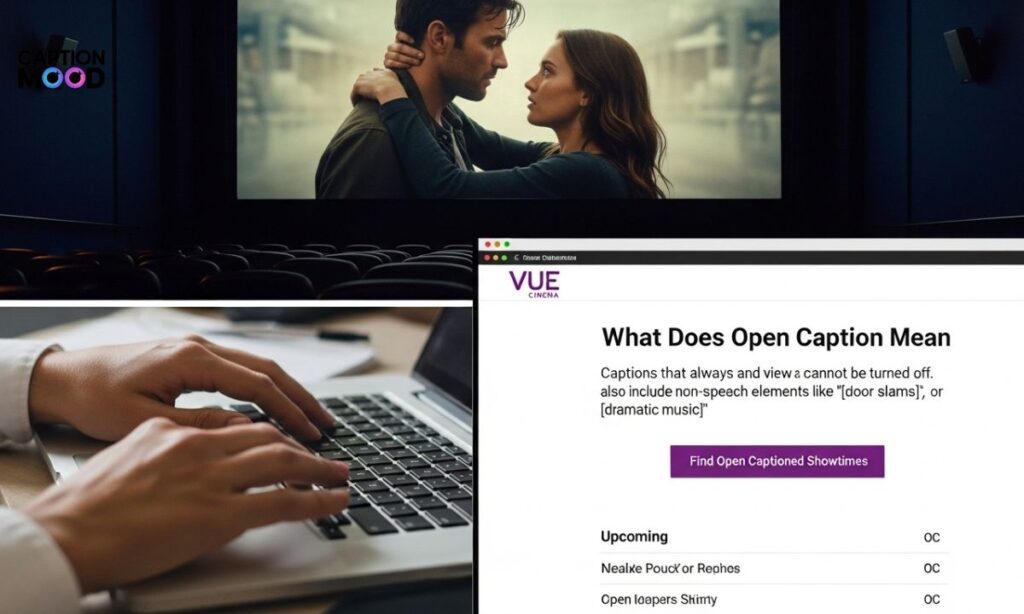
At Vue Cinemas, an open caption screening means that the film’s dialogue and sound descriptions are displayed on-screen for all viewers. These screenings are part of Vue’s accessibility initiative, allowing people with hearing difficulties to enjoy movies without requiring personal captioning devices.
Open captions at Vue are synchronized with the movie in real-time, and the text is usually clear, readable, and color-contrasted for better visibility. Vue often lists these screenings specifically, making it easy for audiences to choose accessible showtimes.
What Does Open Caption Mean in Theatre
In theatre, an open caption refers to text displayed on a screen or projected above the stage that conveys dialogue, lyrics, or sound effects for all audience members. These captions are always visible, allowing people who are deaf or hard of hearing to fully enjoy the performance.
Open captions in theatre may also include speaker identification and descriptions of musical cues, ensuring the audience doesn’t miss important context. Many modern theatres now offer open caption performances as part of their accessibility programs, creating a more inclusive experience for all viewers.
What Does Open Caption Mean Broadway
On Broadway, an open caption performance is a show where captions are projected for all audience members, usually on a screen placed above or near the stage. These captions display dialogue, lyrics, and sound effects, making the performance accessible to people who are deaf, hard of hearing, or non-native speakers.
Broadway theatres schedule specific open caption shows, and the text is synchronized with live performances to ensure accuracy. Open caption Broadway shows enhance inclusivity while maintaining the artistic experience for everyone.
What Does Open Caption Mean at Vue Cinema
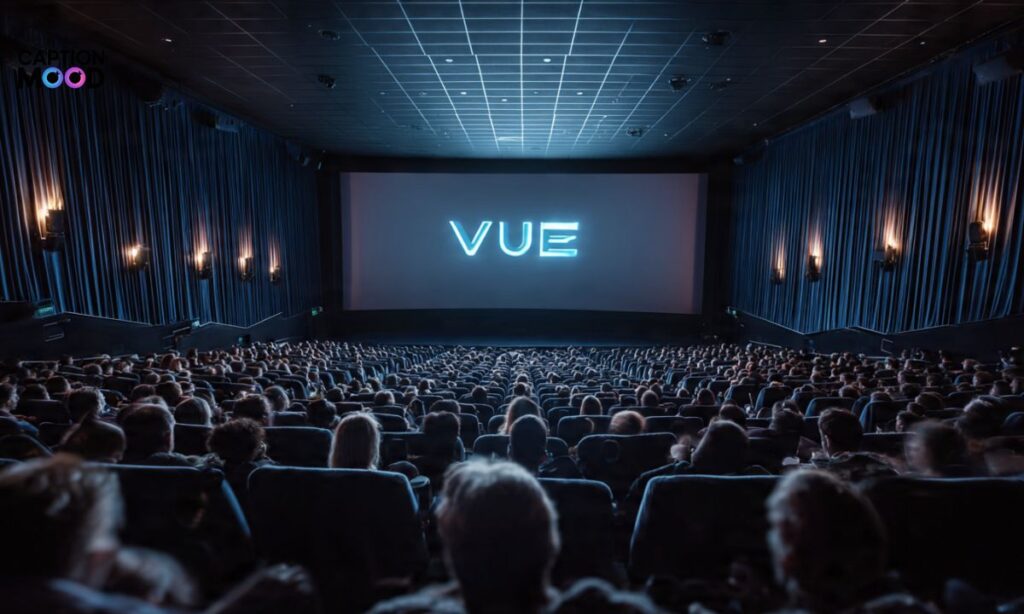
At Vue Cinema, an open caption screening is a movie showing where all dialogue, sound cues, and effects are displayed on-screen for every viewer. Open captions are permanently visible and do not require special devices, making films accessible to people with hearing difficulties or language barriers.
Vue highlights these screenings in their schedule, and the captions are designed to be readable, color-contrasted, and synchronized with the film in real time. Open captions at Vue ensure inclusive cinema experiences, allowing audiences to enjoy movies fully without missing any dialogue or important sound cues.
Examples of Open Captions
To make it clearer, let’s explore a few real-world examples of where you’ll find open captions:
- Cinema Screenings: Some theaters advertise “Open Caption Showtimes” for inclusive viewing.
- Social Media Videos: Platforms like TikTok and Instagram reels often use burned-in text as open captions for better reach.
- Educational Videos: Teachers or trainers add captions so students can follow lessons even in noisy environments.
- Public Displays: Videos played in waiting areas, exhibitions, or airports often feature open captions for clarity.
These examples highlight how open captions aren’t just about accessibility — they also help boost engagement, improve watch time, and make videos more SEO-friendly across digital platforms.
How Do Open Captions Work?
Open captions are created during the video editing process and become a permanent part of the video file. This means they can’t be removed or turned off by the viewer. Here’s a simple step-by-step breakdown:
- Transcribe the Audio – Convert all dialogue and sounds into text.
- Sync Text with Video – Align captions accurately with the timing of spoken words.
- Embed Captions into Video – Use video editing tools like Adobe Premiere Pro, Final Cut Pro, or Kapwing to burn captions permanently into the video.
- Export & Upload – Once the captions are part of the video, it’s ready to be uploaded anywhere—no extra files needed.
This process ensures consistent accessibility across all devices and platforms. Whether your viewer is on a phone in a noisy street or watching in a quiet theater, open captions make your message clear, readable, and inclusive for everyone.
Why Use Open Captions?
Open captions aren’t just for accessibility — they’re a powerful communication tool. They help your content reach a wider, more inclusive audience by making sure everyone can understand your message, even in noisy places or without sound. Whether you’re a content creator, educator, or business owner, using open captions improves watch time, clarity, and viewer engagement.
In short, open captions make your content clearer, searchable, and audience-friendly across every platform.
Social Media
In today’s scrolling culture, most videos are watched without sound — especially on platforms like Instagram, TikTok, and Facebook. That’s where open captions become game-changers.
Adding open captions ensures your message is still understood, even when audio is muted. It also helps your video perform better in terms of reach, SEO visibility, and retention. Many viral creators use burned-in text captions to grab attention, boost accessibility, and encourage viewers to stop scrolling and watch.
So, if you want higher engagement and longer watch time, open captions are your best friend.
Film Screenings
In cinemas or film festivals, open caption screenings make the movie experience inclusive for deaf or hard-of-hearing audiences. Unlike closed captions that require special devices, open captions are visible to everyone on the big screen.
Many theaters — including major chains — now schedule open caption showtimes so that accessibility isn’t a barrier. It’s an initiative that supports diversity, inclusion, and equal viewing experiences for all.
Videos in Public Spaces
When videos are displayed in airports, gyms, restaurants, hospitals, or classrooms, audio isn’t always clear or even allowed.
Here, open captions are essential because they communicate the video’s message silently but effectively. Businesses and educators use them to make sure the audience understands information without needing headphones or speakers.
It’s a simple yet professional way to ensure your video remains impactful in any environment.
What Does Open Caption Mean on Instagram?
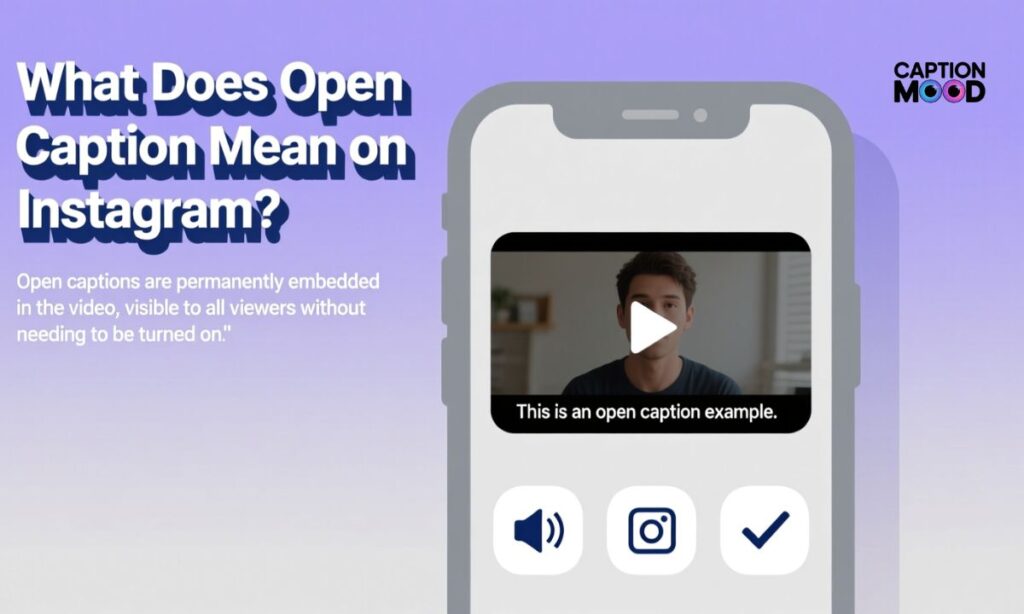
On Instagram, open caption means the text is permanently embedded in your video or reel. Unlike automatic subtitles or “caption stickers,” open captions stay visible on every device, no matter what.
Creators use them to ensure viewers instantly grasp the message, especially since most people watch Instagram Reels without sound.
Open captions also help your content perform better with keywords and discoverability, making it easier to attract new followers and engagement organically.
What Is Open Caption vs Closed Caption?
Here’s a simple comparison to make it clear:
| Feature | Open Captions | Closed Captions |
| Visibility | Always visible on screen | Can be turned on or off |
| Format | Burned into video file | Separate text file (like .srt) |
| Accessibility | Universal – visible everywhere | Requires device or player support |
| Use Case | Public videos, cinemas, social media | YouTube, TV broadcasts, streaming platforms |
In short:
Open captions are permanent and seen by all, while closed captions are optional and device-dependent. Both serve accessibility — the choice depends on how and where your video is viewed.
What Does Open Caption Mean AMC?
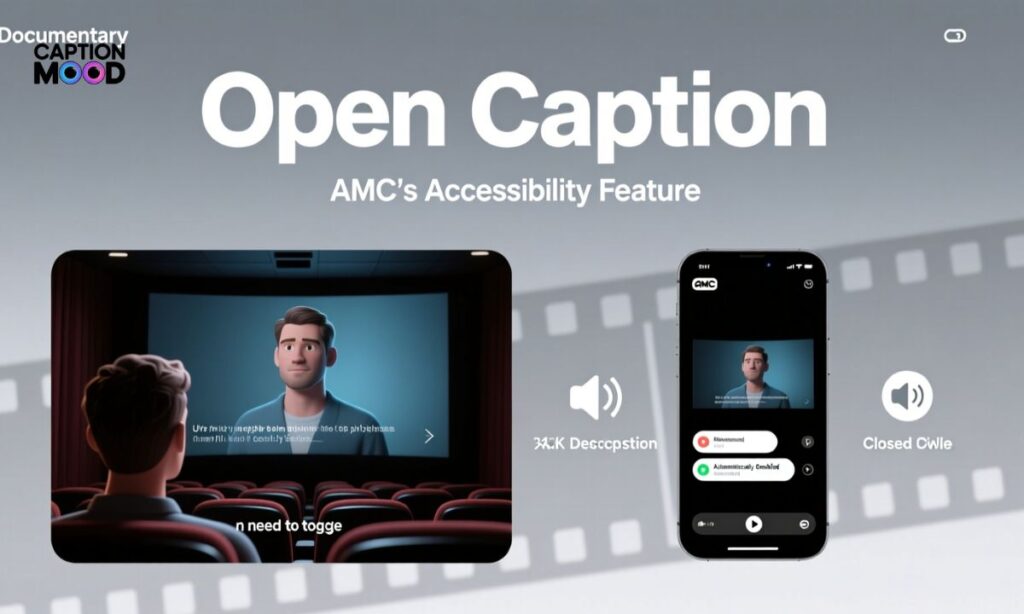
At AMC Theatres, “Open Caption” means that the movie will be played with permanent on-screen text showing all dialogue and sound descriptions. These screenings are specially designed for deaf and hard-of-hearing guests, but anyone can attend.
You’ll often see listings labeled as “Open Caption Showtimes” on AMC’s website or app.
It’s a great way AMC supports inclusive cinema experiences, ensuring every viewer can enjoy movies fully, without missing a single word or sound cue.
Do Open Caption Movies Have Sound?
Yes, open caption movies absolutely have sound. The captions are simply text displayed on the screen showing spoken dialogue, music lyrics, and sound effects — but the original audio track still plays normally.
These captions are designed to assist deaf, hard-of-hearing, or non-native speakers, but anyone can enjoy them. So, when you attend an open caption screening, you’ll hear everything just like in a regular movie — the captions just make it easier to follow along.
Open Caption Examples
To make things clear, let’s look at some examples of how open captions appear across different platforms:
| Platform / Context | Example of Open Caption Use |
| Movie Theater | Subtitles showing dialogue and sound effects visible to all viewers. |
| Social Media Video | Text permanently displayed on a reel or TikTok explaining spoken words. |
| Educational Video | Lesson content with burned-in text so students can follow easily. |
| Public Advertisement | Screen in a mall or airport showing text for announcements or ads. |
These examples show how open captions are useful beyond just accessibility — they also increase engagement, retention, and comprehension across diverse audiences.
What Does Closed Caption Mean?
Closed captions (CC) are subtitles that include both spoken dialogue and sound effects, but unlike open captions, they can be turned on or off by the viewer.
They’re stored as a separate text file (like an .srt or .vtt file) and displayed only when the user enables captions on their device or streaming platform.
Closed captions are common on YouTube, Netflix, and TV shows, helping viewers follow the content when the sound isn’t clear or when they prefer reading along.
In short, closed captions give control to the viewer, while open captions are visible for everyone automatically.
AMC Closed Caption
At AMC Theatres, closed captioning is offered for most movies, providing text of the dialogue and sound effects on a personal display device that attaches to your seat.
This means only you can see the captions, while others watch the movie normally.
AMC’s closed caption devices are part of their Assistive Moviegoing Services, which support deaf and hard-of-hearing audiences while keeping flexibility for others.
You can easily check if a movie supports closed captioning by looking for the “CC” icon next to the movie title on AMC’s website or app.
Closed Caption vs Open Caption AMC
Here’s a quick comparison between open caption and closed caption screenings at AMC Theatres:
| Feature | Open Caption (OC) | Closed Caption (CC) |
| Visibility | Always visible to all viewers on screen | Visible only to user on a personal device |
| Experience | Shared captions for everyone | Private captions for individuals |
| Control | Cannot be turned off | Can be turned on/off as needed |
| Best For | Inclusive group viewing | Personalized accessibility |
| AMC Label | “Open Caption Showtime” | “Closed Caption Available” |
In summary, open captions make every movie inclusive by default, while closed captions offer a customized experience for individuals who need them.
Both systems show AMC’s strong commitment to accessibility, comfort, and inclusion in entertainment.
AMC Open Caption
At AMC Theatres, Open Caption (OC) showtimes are screenings where subtitles are permanently displayed on the screen for everyone to see. These captions show all spoken dialogue, background sounds, and important audio cues making the experience inclusive and comfortable for deaf and hard-of-hearing guests.
AMC lists these sessions clearly as “Open Caption Showtimes” on their website and app. Anyone can attend these screenings, whether they rely on captions or simply prefer reading along. It’s a brilliant move by AMC to promote equal access, clarity, and understanding for all audiences, without needing special devices or settings.
The Benefits of Open Captions
Open captions bring multiple benefits not only for accessibility but also for improving communication, viewer engagement, and reach. Let’s break it down:
| Benefit | Description |
| Accessibility for All | Ensures everyone, including deaf or hard-of-hearing audiences, can understand the content. |
| Better Engagement | Keeps viewers watching longer on social platforms where videos autoplay without sound. |
| Improved SEO | Captions include readable text that boosts discoverability on YouTube and Google. |
| Global Understanding | Helps non-native speakers follow along easily. |
| Professional Appeal | Adds clarity, making your content look polished and inclusive. |
Open captions turn videos into universal storytelling tools — bridging gaps between cultures, languages, and hearing abilities. They don’t just make your content accessible; they make it stronger and smarter for every viewer.
Create Studio-Grade Videos in Seconds
You don’t need expensive gear to make professional, captioned videos anymore.
Modern tools like Kapwing, Veed.io, Descript, and Adobe Premiere Pro make it easy to auto-generate open captions and style them for brand consistency.
With just a few clicks, you can:
- Auto-transcribe your speech into text
- Sync captions perfectly with your video timeline
- Customize fonts and colors for better visibility
- Burn captions permanently into the final export
Using these tools, even a beginner can create studio-grade, accessible videos in minutes, ready to post on Instagram, YouTube, TikTok, or business websites.
Drawbacks of Open Captions
While open captions have many advantages, it’s fair to understand their limitations too.
Here are some common drawbacks to consider before finalizing your video style:
| Drawback | Description |
| Permanent Display | Once added, captions can’t be turned off, which may distract some viewers. |
| Editing Limitations | You need to re-edit the video if any caption errors appear. |
| Design Challenges | Wrong color or font can reduce readability on certain backgrounds. |
| No Multilingual Flexibility | You can’t switch languages like closed caption systems allow. |
Even with these drawbacks, open captions remain the preferred choice for accessibility and public-facing content, especially when clarity and inclusivity are top priorities.
Open Captioning Examples
Let’s look at some practical examples where open captioning makes a visible difference:
- 🎬 Cinema Experience (AMC, Regal, etc.) – Movie dialogue and sound effects shown for all viewers.
- 📱 Social Media Videos (Instagram, TikTok, YouTube Shorts) – Burned-in text that grabs attention in silent autoplay feeds.
- 🧑🏫 Educational Tutorials & eLearning – Clear captions help students follow lessons in noisy environments.
- 🏢 Corporate Presentations & Ads – Captions ensure your brand’s message is understood even without audio.
- 🏟️ Public Displays – Screens in gyms, malls, or airports where sound isn’t practical.
These examples prove that open captions go far beyond accessibility they’re now a branding, communication, and engagement strategy that every modern creator or company can benefit from.
What is Open Captioning?
Open captioning means displaying text permanently on a video or movie screen that represents the spoken dialogue, sound effects, and background audio.
Unlike closed captions, open captions are always visible and cannot be turned off. They are built directly into the video file itself.
This type of captioning is widely used in cinemas, classrooms, online courses, and social media videos to make content accessible, inclusive, and easy to follow for everyone — especially deaf or hard-of-hearing viewers.
In short, open captioning ensures your message is seen and understood, even when the sound isn’t available.
Pros and Cons
Like every tool, open captioning has both strengths and drawbacks. Let’s compare both sides clearly:
| Pros | Cons |
| Enhances accessibility for all viewers | Captions are permanent — can’t be turned off |
| Improves video SEO and engagement | Requires accurate syncing during editing |
| Helps non-native speakers understand dialogue | Wrong font or placement can reduce readability |
| Boosts watch time on muted videos | No flexibility to switch languages |
| Adds professional touch to all content | More effort required in production |
Bottom line: The benefits of open captions far outweigh the downsides, especially for creators aiming for global reach and inclusive content.
When to Use Open Captions?
You should use open captions whenever your content will be viewed in public, muted, or noisy environments, or by a diverse audience. Here are some ideal situations:
- 🎬 In Theaters – For inclusive screenings where everyone should see dialogue clearly.
- 📱 On Social Media – When users scroll without sound, captions make them stop and engage.
- 🧑🏫 Educational or Training Videos – So learners can read along even with poor audio.
- 🏢 Corporate or Marketing Content – Captions ensure your message is never missed in presentations or ads.
- ✈️ Public Displays or Airports – Videos remain understandable without relying on sound.
By adding open captions strategically, you make your videos accessible, searchable, and professional, all at once.
How Do Open Captions Appear on Different Social Media Platforms?
Open captions look slightly different across social platforms depending on the layout, screen size, and algorithmic preferences.
Here’s a breakdown of how they work and why they matter on major platforms:
On Instagram, open captions appear as burned-in text directly on your Reels or videos.
Because over 80% of users watch Reels without sound, captions help grab attention instantly.
They improve engagement, retention, and accessibility, while also boosting your content’s chances of appearing on the Explore page.
Many creators use bold fonts and contrasting colors so captions stand out and stay readable on mobile screens.
If you’re serious about growth, adding open captions to every Reel is a must.
YouTube
On YouTube, open captions are less common but extremely effective for branding and accessibility.
While the platform supports closed captions (.srt files), some creators prefer open captions to control the style, timing, and placement permanently.
Open captions ensure consistency across devices, especially when viewers watch on smart TVs or embedded players where closed captions may not display properly.
Plus, when YouTube indexes your captions’ text, it improves your video’s SEO ranking and keyword visibility helping you reach more viewers naturally.
Frequently Asked Questions
What does open caption mean in movies?
Open caption in movies means text is permanently displayed on the screen showing dialogue and sound effects for all viewers.
What does open caption mean on Instagram?
On Instagram, open caption means the text is burned directly into the video, visible to everyone even when sound is off.
What does open caption mean at AMC?
At AMC Theatres, open caption showtimes display dialogue and sound descriptions on the big screen for all moviegoers.
What is the difference between open and closed caption?
Open captions are always visible on the video, while closed captions can be turned on or off by the viewer.
Do open caption movies have sound?
Yes, open caption movies have full sound; captions only provide visual text for dialogue and audio cues.
What does open caption mean in theaters?
In theaters, open caption means subtitles are shown on screen for everyone, improving accessibility for deaf or hard-of-hearing viewers.
Why do people use open captions?
People use open captions to make videos accessible, improve understanding, and boost engagement on social media and public screens.
What does open caption mean on YouTube?
On YouTube, open caption means the text is permanently embedded in the video, ensuring consistent visibility on all devices.
Conclusion
Understanding what open caption means helps creators and viewers appreciate the importance of accessibility. Open captions make content clear, inclusive, and engaging for everyone whether you’re watching in a theater, scrolling social media, or learning online. They ensure no message goes unheard or unseen.

Hi, I’m Emily Carter, the mind and heart behind CaptionMood — a creative space designed to help you express your thoughts with the perfect words.
As a writer and digital content enthusiast, I’ve always believed that captions are more than just text; they’re emotions, stories, and reflections of who we are. With CaptionMood, my mission is to provide unique and engaging Mood Captions, Occasion Captions, and Social Media Captions that resonate with people from all walks of life.
Thank you for visiting and being part of this journey. Through CaptionMood, I hope to inspire, connect, and make every post more meaningful.
